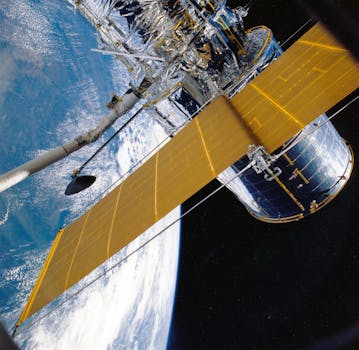
The Future of Satellites: Revolutionizing Global Communication and Exploration. The future of satellites holds immense promise, with advancements in technology and innovation poised to revolutionize global communication, exploration, and more. Over the years, satellites have played a crucial role in shaping our understanding of the world and beyond, from facilitating global communication and navigation to enabling scientific research and exploration.
Satellites have come a long way since the launch of the first artificial satellite, Sputnik, in 1957. Today, there are thousands of satellites orbiting the Earth, each with its unique purpose and function. The future of satellites looks even more promising, with advancements in technology and innovation poised to take satellite technology to new heights.
One of the most significant developments in satellite technology is the advent of small satellites, also known as cube satellites or smallsats. These tiny satellites, which are often no larger than a shoebox, have made it possible for organizations and individuals to launch their own satellites into space at a fraction of the cost of traditional satellites. This has democratized access to space, enabling a wide range of applications, from Earth observation and communication to scientific research and exploration.
Advancements in Satellite Technology
Advances in satellite technology are driving innovation and growth in the industry. One of the key areas of focus is the development of more efficient and powerful propulsion systems. Traditional satellites rely on chemical propulsion systems, which are heavy and inefficient. Newer propulsion systems, such as electric propulsion and advanced ion engines, offer greater efficiency and longer mission durations.
Another area of advancement is in the field of materials science. New materials and technologies, such as advanced composites and 3D printing, are being developed to create lighter, stronger, and more durable satellite components. This is enabling the creation of larger and more complex satellites, as well as smaller and more agile satellites that can be launched at lower cost.
The use of artificial intelligence and machine learning is also becoming more prevalent in satellite technology. AI and ML algorithms can be used to analyze vast amounts of data generated by satellites, enabling real-time monitoring and decision-making. This has significant implications for applications such as Earth observation, weather forecasting, and communication.
Applications of Satellites
Satellites have a wide range of applications, from global communication and navigation to scientific research and exploration. One of the most significant applications of satellites is in the field of communication. Satellites enable global communication by providing a means of transmitting data and signals around the world. This has revolutionized the way we communicate, enabling instant communication with people on the other side of the world.
Satellites are also used for navigation, providing location information and timing signals that enable GPS and other navigation systems to function. This has had a significant impact on industries such as aviation, maritime, and transportation, enabling more efficient and safe navigation.
Satellites are also used for scientific research and exploration. They enable us to study the Earth and other planets in unprecedented detail, providing valuable insights into the workings of the universe. Satellites have also played a crucial role in space exploration, enabling us to send probes to other planets and celestial bodies.
Challenges and Opportunities
Despite the many advancements and innovations in satellite technology, there are still significant challenges to be addressed. One of the major challenges is the issue of space debris, which poses a significant threat to the safety and sustainability of satellite operations. As the number of satellites in orbit continues to grow, the risk of collisions and other accidents increases.
Another challenge is the issue of regulation and governance. The satellite industry is subject to a complex and often confusing array of regulations and laws, which can make it difficult to navigate and comply with. There is a need for clearer and more consistent regulation, as well as greater international cooperation and coordination.
Despite these challenges, the future of satellites looks bright. The opportunities presented by satellite technology are vast and varied, from enabling global communication and navigation to facilitating scientific research and exploration. As technology continues to advance and innovate, we can expect to see even more exciting developments and applications in the years to come.
Conclusion
In conclusion, the future of satellites is an exciting and rapidly evolving field, with advancements in technology and innovation poised to revolutionize global communication, exploration, and more. From the development of small satellites and advancements in propulsion systems to the use of artificial intelligence and machine learning, the possibilities presented by satellite technology are vast and varied.
As we look to the future, it is clear that satellites will play an increasingly important role in shaping our world and beyond. Whether it is enabling global communication and navigation, facilitating scientific research and exploration, or providing critical services such as weather forecasting and disaster response, satellites are an essential part of our daily lives.

